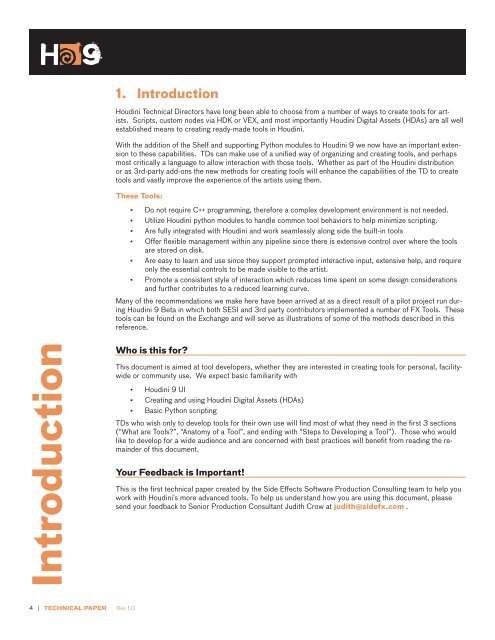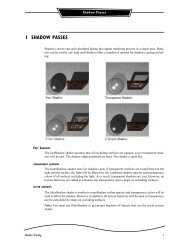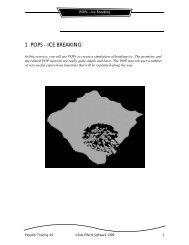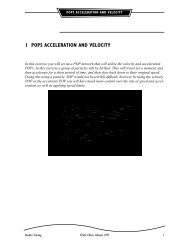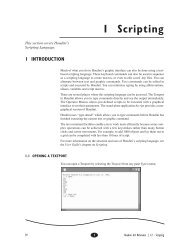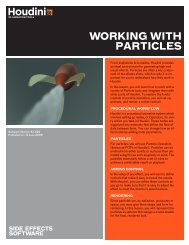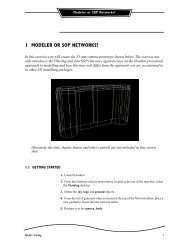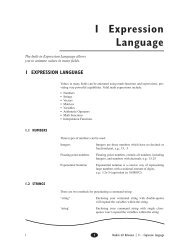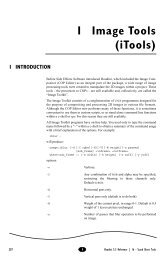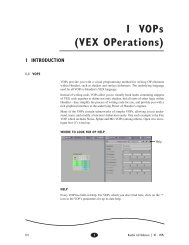TECHNICAL PAPER Building Tools for Houdini 9
TECHNICAL PAPER Building Tools for Houdini 9 - Digital Cinema Arts
TECHNICAL PAPER Building Tools for Houdini 9 - Digital Cinema Arts
- No tags were found...
You also want an ePaper? Increase the reach of your titles
YUMPU automatically turns print PDFs into web optimized ePapers that Google loves.
1.Introduction<strong>Houdini</strong> Technical Directors have long been able to choose from a number of ways to create tools <strong>for</strong> artists.Scripts, custom nodes via HDK or VEX, and most importantly <strong>Houdini</strong> Digital Assets (HDAs) are all wellestablished means to creating ready-made tools in <strong>Houdini</strong>.With the addition of the Shelf and supporting Python modules to <strong>Houdini</strong> 9 we now have an important extensionto these capabilities. TDs can make use of a unified way of organizing and creating tools, and perhapsmost critically a language to allow interaction with those tools. Whether as part of the <strong>Houdini</strong> distributionor as 3rd-party add-ons the new methods <strong>for</strong> creating tools will enhance the capabilities of the TD to createtools and vastly improve the experience of the artists using them.These <strong>Tools</strong>:▪▪▪▪▪▪▪▪▪▪▪▪Do not require C++ programming, there<strong>for</strong>e a complex development environment is not needed.Utilize <strong>Houdini</strong> python modules to handle common tool behaviors to help minimize scripting.Are fully integrated with <strong>Houdini</strong> and work seamlessly along side the built-in toolsOffer flexible management within any pipeline since there is extensive control over where the toolsare stored on disk.Are easy to learn and use since they support prompted interactive input, extensive help, and requireonly the essential controls to be made visible to the artist.Promote a consistent style of interaction which reduces time spent on some design considerationsand further contributes to a reduced learning curve.Many of the recommendations we make here have been arrived at as a direct result of a pilot project run during<strong>Houdini</strong> 9 Beta in which both SESI and 3rd party contributors implemented a number of FX <strong>Tools</strong>. Thesetools can be found on the Exchange and will serve as illustrations of some of the methods described in thisreference.IntroductionWho is this <strong>for</strong>?This document is aimed at tool developers, whether they are interested in creating tools <strong>for</strong> personal, facilitywideor community use. We expect basic familiarity with▪▪▪▪▪▪<strong>Houdini</strong> 9 UICreating and using <strong>Houdini</strong> Digital Assets (HDAs)Basic Python scriptingTDs who wish only to develop tools <strong>for</strong> their own use will find most of what they need in the first 3 sections(“What are <strong>Tools</strong>?”, “Anatomy of a Tool”, and ending with “Steps to Developing a Tool”). Those who wouldlike to develop <strong>for</strong> a wide audience and are concerned with best practices will benefit from reading the remainderof this document.Your Feedback is Important!This is the first technical paper created by the Side Effects Software Production Consulting team to help youwork with <strong>Houdini</strong>’s more advanced tools. To help us understand how you are using this document, pleasesend your feedback to Senior Production Consultant Judith Crow at judith@sidefx.com .4 | <strong>TECHNICAL</strong> <strong>PAPER</strong> Rev 1.0


